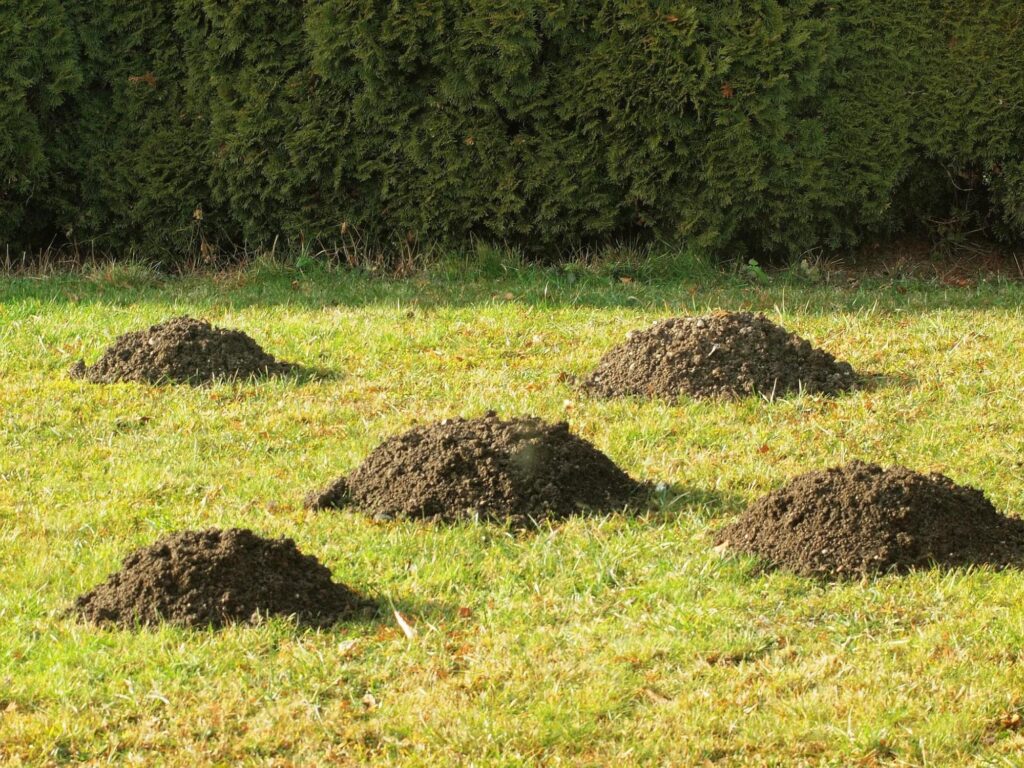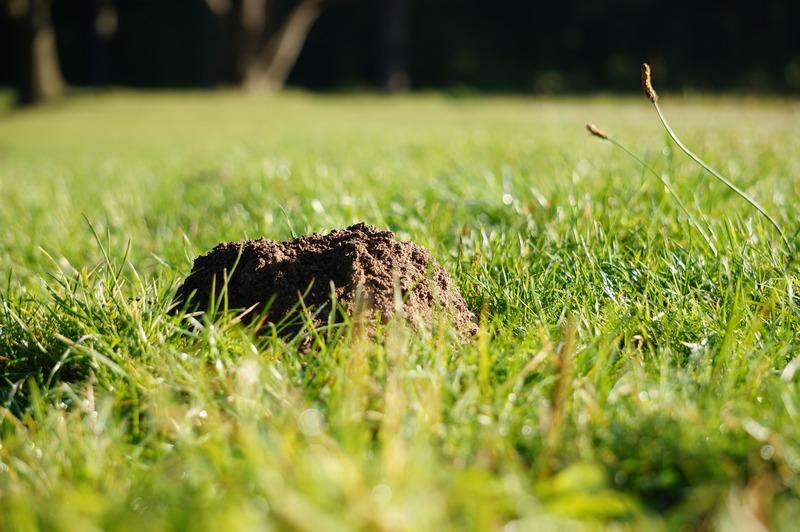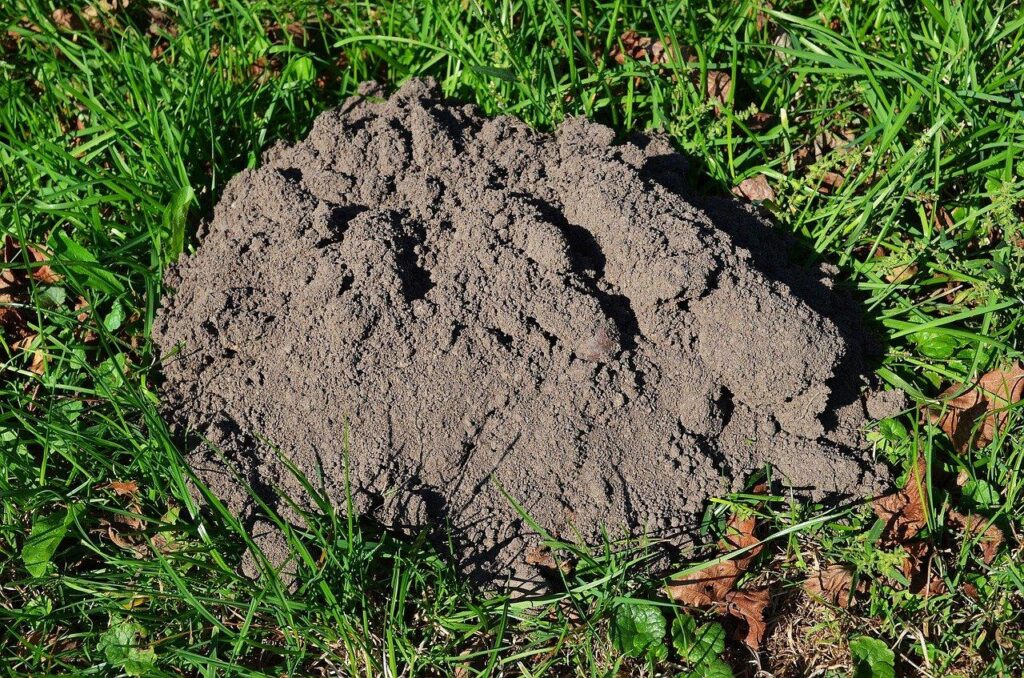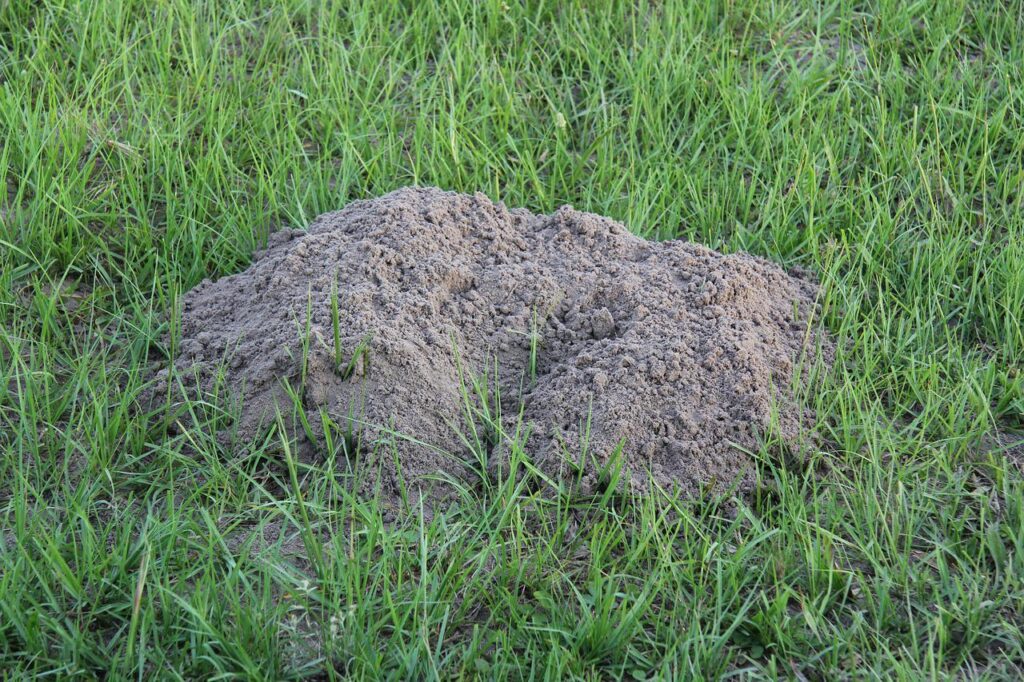A bumpy, lumpy, rough and uneven lawn is not just aesthetically displeasing and annoying; it can also become a trip and fall hazard. Also, these lawn bumps or dirt mounds might make mowing extremely difficult which makes this tiresome task even more frustrating. A bumpy lawn is a problem that every lawn owner has to face sooner or later. In this article, learn how to prevent small dirt mounds in your lawn.

An extremely lumpy lawn is not just unsightly, but it also indicates a severe pest problem.
So, if you also have little dirt mounds on your lawn, you might be wondering what these mounds are, where they came from, who is building them, and what you should do about them. Continue reading this article for an in-depth insight into dirt mounds!
What Is A Dirt Mound?

Not all dirt mounds indicate danger and need to be removed unless they become a visual nuisance.
Dirt mounds are lumps of lawn soil that erupt mysteriously overnight in yards with their architectures and builders nowhere to be found. These lumps are indeed an unsettling sight, and whether it is only a few or a lot, you will want to get rid of them.
Dirt mounds come in various shapes and sizes. Some are tiny and inconspicuous that you might not even notice them. At the same time, others are large and hideous. However, not all dirt mounds on your lawn indicate a potential problem.
Some of them can even be a sign of healthy soil. For instance, dirt mounds made by earthworms are a good sign. It is because these lawn intruders help lawn soil flip and bring nutritious soil to the top. However, even dirt mounds made by earthworms can become a visual nuisance if they are too much in number.
Then there are dirt mounds made by ground-dwelling rodents such as moles and gophers. Identifying the culprit behind the dirt mounds is necessary if you are to deal with your lawn’s dirt mound problem properly.
So, let’s go ahead and learn what causes small dirt mounds in lawns, are they bad for your yard, and if they are, how do you get rid of them? Happy Reading!
What Causes Small Dirt Mounds In Lawn?
If you suddenly start finding lumps of mud in your yard with no clue of what is building them, it is most likely a wildlife creature trying to take over your lawn. More often than not, these small dirt mounds are made by insects and earthworms. However, sometimes other animals such as moles, rats and gophers might also be the culprit.
So, let’s go ahead and look at each of these animals and the dirt mounds created by them. This will help you identify the cause behind the emergence of dirt mounds on your lawn and assist you in choosing the proper treatment method:
Ant Mounds

Ant mounds are created by soil-nesting ants lurking beneath the surface of your turf.
Many ant species inhabit lawns and other turf areas. Most of them are considered beneficial and often do not require any control. However, ants can indirectly become a problem if they construct unsightly mounds all over the lawn surface. Also, ants from these mounds can enter homes in search of food.
Ants build these mud hills or mounds by bringing the granular soil to the top from their nest below. In addition to being unsightly, these ant hills can also make the surface of the lawn uneven, making mowing difficult. Also, if these ant mounds are large enough, they can smother the grass in the surrounding areas.
More often than not, these ant hills or ant mounds are pretty harmless. However, if their numbers increase too much, they can cause significant cosmetic and health damage to the grass. In situations where ants start damaging the grass roots, control becomes necessary.
It is because too much damage to grass roots can kill the grass plants, and you will end up with patchy turf and lots of bare spots in your yard. Keep reading the article to learn how you can get rid of ant mounds and fix a bumpy lawn.
Worm Mounds

Earthworms are usually the main suspect behind tiny mud mounds on the lawn.
Earthworm mounds are most frequently seen on lawns when night time temperatures become relatively warm. These mounds, also known as castings, are made of clumps of granular soil that earthworms feed on and scatter over the entire lawn during the night. They can be seen as a lawn nuisance when they become too numerous.
This usually happens when the lawn grass grows too slow or lies dormant. During these times, lawn owners stop mowing their lawns, which would have knocked down the growing worm wounds otherwise. As a result, earthworm mounds become more apparent on the lawn surface. These castings can also black drainage systems of the lawn.
However, in most cases, earthworm castings are considered a good sign. It is because as earthworms tunnel through the soil, they leave tiny air spaces behind which aids in soil aeration. Without aeration, fresh air, nutrients and water would have a much harder time reaching the root zone, and grass growth will be severely affected.
Not just that, they also help spread vital organic matter throughout the lawn soil. Earthworm activity, if not a nuisance, should be encouraged on lawns. It improves soil structure, facilitates water movement, and prevents thatch buildup in the yard.
RELATED: What Is Digging Holes In Your Lawn? Causes and Solutions
Mole Mounds

Mole mounds are relatively large and quite apparent on the lawn surface.
Usually, when people discover volcano-shaped mounds on their lawns, they are quick to blame it on ants or the neighbor’s kid who did a poor job burying his resort card. However, ground-dwelling animals such as moles could also be the culprit behind the overnight appearance of volcano-like mounds in your yard.
Moles usually spend their lives underground, and many of their subterranean activities typically go unnoticed. However, when moles are really hungry and dig an extensive tunnel network under your turf, the soil they remove gets pushed to the surface, giving rise to these unsightly mounds on your lawn.
Other than mounds, signs of mole infestation can also include slightly raised trails that go from pile to pile of scattered soil in the yard. Unfortunately, these trails can also lead to the development of raised ridges on your turf, ruining the whole aesthetics of the lawn.
The mole mounds and ridges are most apparent during the spring, early summer months, and then again in the fall. During these times, moles usually live closer to the surface. Keep reading the article to learn how you can fix a ridged turf.
Gopher Mounds

Gophers can also be the culprit behind large mounds of fresh soil on your lawn.
Many people often mistake gopher mounds with mole mounds. This often leads to frustration as moles and gophers are controlled using slightly different methods. However, do not worry; we have got you covered! You can easily differentiate between mole and gopher mounds by looking at them from above.
Gopher mounds have somewhat of a horse-shoe or crescent shape when looked at from above. Also, the hole in the mound is on one side and is typically plugged. On the other hand, mole mounds are volcano-shaped, circular, and have holes in the middle.
A gopher can create many mounds in a single day and ruin entire lawns, gardens and flower beds if not controlled. They are very active when the soil is moist and has grubs.
How Do You Get Rid Of Dirt Mounds?
Now that we know about the different causes and types of mounds on the lawns, we can dig deeper and learn how to eradicate and prevent dirt mounds in the yard effectively. Here’s how you can do it:
- When you notice dirt mounds on your lawn, the first thing to do is identify the culprit behind them and get rid of it. Following that, you can move towards fixing your lumpy lawn.
- If it is insects or bugs, you can use chemicals to control their numbers. However, chemicals might also affect beneficial insects in your yard. Another thing you can do to control the insect population in your yard is to eliminate their food source.
- Worm mounds are easy to get rid of. You can simply use a rake to knock them over on your lawn. This activity will also spread nutrient-rich castings over the turf, which would help grass growth.
- If the mounds are due to gophers and moles, we suggest flushing them out with water or using traps. There are many excellent videos on YouTube that you can check out to see how to set a mole trap in your yard.
- Once you have eliminated those mound architects, you can move towards fixing the ridged turf. First of all, use a rake to spread the mound dirt over your lawn. Then, if the lawn is too bumpy, you can use a heavy roller to flatten it out.
- Once done, ensure that you aerate the soil to avoid compaction issues.
Sources For Further Reading
- What Causes Tiny Mounds of Soil in My Lawn? N.C. Cooperative Extension. (2015). Retrieved 14 May 2022, from https://pitt.ces.ncsu.edu/2015/11/what-causes-tiny-mounds-of-soil-in-my-lawn-2/
- Turf > Uneven bumps, mounds, or ridges in the lawn. The University of Minnesota Extension. (2022). Retrieved 14 May 2022, from https://apps.extension.umn.edu/garden/diagnose/plant/turf/bumps.html
- Tiny soil mounds everywhere in the lawn (12-7-09) | Mississippi State University Extension Service. Retrieved 14 May 2022, from https://rb.gy/99rlb3
Now that you know how to prevent small dirt mounds in lawn, make sure to also check out our other articles and learn how to maintain your lawn properly:
Top 10 Super Easy And Effective Ways Of Fixing A Muddy Yard
Why Is My New Sod Turning Brown | How To Keep New Sod From Turning Brown
What Type Of Grass Grows Best In Clay Soil | Best Grasses For Clay Soil







